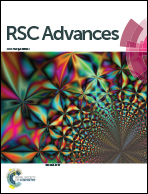Tin doped PrBaFe2O5+δ anode material for solid oxide fuel cells†
Abstract
Ceramic anodes have many advantages over cermet anodes for solid oxide fuel cells. We report the synthesis and characterization of Sn doped double perovskite PrBaFe(2−x)SnxO5+δ (x = 0–0.3) anode materials. Different crystal structures were observed depending on the Sn doping level and gas atmosphere. The materials demonstrated excellent stability in both reducing and redox atmospheres at elevated temperatures. The oxygen content in the as-prepared PrBaFe(2−x)SnxO5+δ was nonlinearly correlated to the Sn doping level and reached maximum values around x = 0.1. After the reducing treatment, the oxygen content linearly decreased with increasing Sn doping level. The electrical conductivity of bulk PrBaFe(2−x)SnxO5+δ (x = 0.1) reached 63.6 S cm−1 at 800 °C in humidified hydrogen. At 750 °C, the surface exchange coefficient and bulk diffusivity of PrBaFe(2−x)SnxO5+δ reached the maximum values of 4.42 × 10−6 m s−1 and 6.04 × 10−7 m2 s−1, respectively, in the reducing process when the Sn doping level was x = 0.1. The activation energies of surface exchange coefficient and bulk diffusivity of PrBaFe(2−x)SnxO5+δ (x = 0.1) were 0.22 eV and 0.16 eV, respectively, in the reducing process. The area specific resistance of the PrBaFe(2−x)SnxO5+δ (x = 0.1) anode was 0.095–0.285 Ω cm2 from 850–750 °C in humidified hydrogen, better than or comparable to the best ceramic anodes in the literature.



 Please wait while we load your content...
Please wait while we load your content...